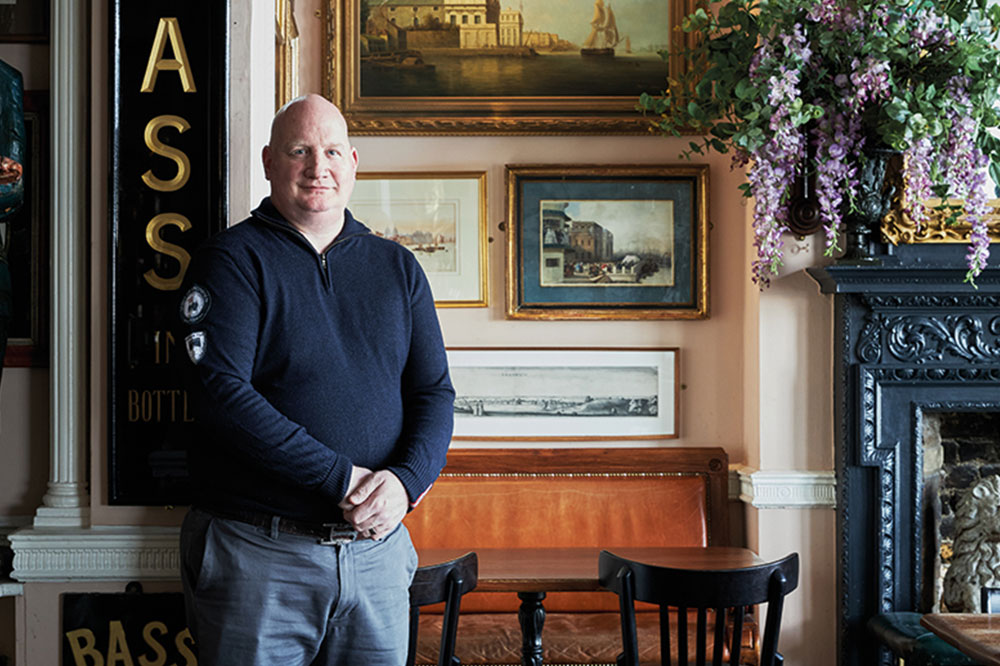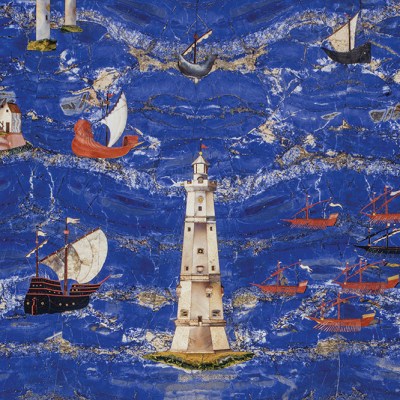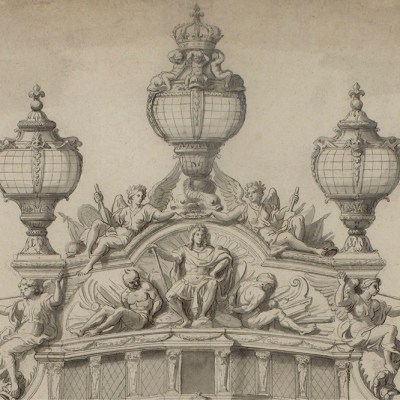From the March 2023 issue of Apollo. Preview and subscribe here.
Standing in one of the Trafalgar Tavern’s distinctive bow windows, looking out on to the Thames, I have the sensation that I am not by the river, but on it, in a delightful pleasure boat. The water laps right up under the windows and the reflected light plays on the ceiling. We are in maritime Greenwich – the splendid naval heart of London. Immediately next door is the Old Royal Naval College, the impressive architectural ensemble founded in 1694 as a retirement home for seamen, designed by Christopher Wren. At nearby Deptford and Woolwich Henry VIII established the royal dockyards in 1513. There, for more than four centuries, boats were built, maintained and launched on their international journeys. While the buildings of Greenwich Hospital are stone-clad and grand, and traces of the industrial sublime survive downriver, at the Trafalgar the mood is vernacular and jovial: this is London at the seaside. The building itself is notable for its curvaceous fenestration with charming awnings and balconies suspended directly over the water. Redolent of the Regency terraces of Brighton, Broadstairs and Ramsgate, it is afforded the special protection of Grade-II listed status for its historic and architectural significance.
The Trafalgar was constructed in 1837 on the site of an earlier hostelry known as the Old George. A painting after an original by the marine painter George Chambers (1803–40) displayed in the main bar shows the site before the present building was constructed. The Trafalgar’s architect was Joseph Kay (1775–1847), who was also responsible for the design of the covered market and adjoining streets that continue to define the heart of the town. The new pub was named in honour of Horatio Nelson’s great victory at the Battle of Trafalgar in 1805. By the mid century it was a well-known destination, famous for its whitebait suppers and chosen by Charles Dickens as the setting for the wedding breakfast in Our Mutual Friend (1864–65). The accompanying wood engraving to that episode shows the large windows with the river beyond, conjuring the impression of light and movement that has inspired artists including James Tissot (1836–1902) and Eugène Lami (1800–90) and can still be enjoyed today. In 1880, artist and explorer Frederick Whymper noted that Greenwich was ‘the favourite haunt of the pleasure-loving cockney – an emporium of shrimps, a reservoir of beer’. After its 19th-century heyday, the Trafalgar declined and was split into residential apartments until the mid 1960s when it was revived as a public house. In its current incarnation it flourishes not only as a watering hole but also as the repository for a remarkable collection, brought together by Frank Dowling, the unlikely but compelling impresario of a rich array of oil paintings, watercolours, engravings, etchings, sculptures, ceramics and scientific instruments.
One of the bars at the Trafalgar Tavern. On the back wall are works by Charles Dixon (1872–1934) and Thomas Rowlandson (1757–1827), among others. Photo: Boz Gagovski

Massed on the walls of the principal bar are grand riverscapes, naval portraits, watercolours of ships and depictions of the tavern itself. Shelves at cornice height are populated with models and statues parade on the bar. Upstairs is the main saloon, used primarily for weddings and functions, lined with mezzotints and engravings of naval figures. ‘This,’ declares Horatio Blood, whom Dowling employs as the collection’s curator, ‘is our rock-star wall of admirals.’ But this is not a theme pub. ‘Everything here is authentic; everything is original,’ Frank insists. ‘We love it and the people who work here love it. Visitors love it; that’s why they come here.’ Nor, however, is it a museum. The works are displayed within reach and with theatrical effect. Nevertheless, many of the items are of museum quality, from exquisite river scenes by the Dutch marine painter Willem Van de Velde (1633–1707), who lived for a time in the Queen’s House at Greenwich, to sprawling canvases by John Bratby (1928– 92), resident of nearby Blackheath and closely associated with the Kitchen Sink School of realism. This is a collection driven by personal passion and shared publicly with generosity and spirited flair.
Dowling’s connection with Greenwich began in the late 1990s when he was working in property development and lived in Canary Wharf on the north side of the river. He found the English rather unwelcoming to a young American recently arrived from the East Coast of the United States and so, to occupy his free time, he took to exploring his environs. He recalls the first time he walked through the foot tunnel from the Isle of Dogs and emerged into Greenwich: ‘This marvellous village.’ It was, he reminisces, dirty, dilapidated and a far cry from the growing glass cityscape that defined his professional life: he was immediately smitten. He struck up over-the- counter conversations that developed into friendships with the remaining antique dealers of Greenwich, who were well-known figures around the town: Robin Challis of Relcy Antiques and Dick Moy of the Spread Eagle Yard, as well as Peter Laurie and the map and print dealer Anthony Cross of Warwick Leadlay Gallery. Some of these establishments were by that time in their sunset years, but their proprietors and stock appealed to Dowling, who had been bitten at an early age by the bug of acquisition.
Dowling’s first love was scientific instruments. His uncle was a clock collector in Baltimore, and in his late teens Frank would accompany him to sales and auctions along the north-east coast of the United States: ‘I would buy compasses for, like, 50 dollars, because that was my budget.’ He attended the Pratt Institute in Brooklyn, where he studied construction management and where he was enthralled by his lecturer’s antique theodolite – a precision optical instrument used for measuring angles in surveying. After graduating, Dowling went into property development. By the time he found himself exploring the streets of Greenwich, his budget had grown beyond $50. He bought his own theodolites, telescopes, prints, maps and paintings from the local dealers; he bought properties too, including the Bar du Musée (a bohemian restaurant that had opened in the 1960s) and a house (built, like the Trafalgar, by Joseph Kay) to which Dowling moved, a flit he describes as exchanging his modern penthouse for ‘an English gentleman’s home’.
The Nile Restaurant on the ground floor, densely hung with oils and watercolours of Greenwich and its environs. Photo: Boz Gagovski

The idea of cultured domesticity is evidently a touchstone for Dowling. His favourite film, Sydney Pollack’s Three Days of the Condor (1975), is a thriller featuring Robert Redford, but what captured Frank’s young imagination was the setting of a panelled room containing a bust of Nelson and a portrait of George Washington. Dowling invokes too his childhood memory of ‘Joe the Bum’, who sorted through the trash of the wealthy Upper East side households in Manhattan to find inexplicably discarded genuine treasures that he displayed in his apartment like a cabinet of curiosities. These were the interiors, imagined and experienced, that shaped and continue to inform Dowling’s aesthetic. Masterpieces are hung cheek by jowl with anonymous marketplace discoveries and fine bronzes jostle with Staffordshire figures. His taste is broad and eclectic. There is, however, a definite collecting policy: ‘Our wheelhouse,’ explains Frank with an appropriately nautical turn of phrase, ‘is Greenwich, Deptford, Woolwich, Blackwall, Wapping, things downriver from Tower Bridge, anything prior to the construction of Tower Bridge [in 1886] … anything Trafalgar … anything Nelson …’ I ask Frank if he saw a painting of Greenwich Observatory recently sold in Scotland. ‘Oh yes,’ he affirms, ‘I bought that.’ He scours sales catalogues and websites constantly and parcels arrive every day. His hunting grounds are metropolitan, regional, national and international. The maquette for Robert Tait Mckenzie’s statue of General Wolfe in Greenwich Park was found in a garden in Devon: after a gentle brush-down it now surveys one of the bars. ‘That came from Germany,’ he declares, gesturing towards a naval coat of arms. ‘How did it get there? […] That,’ he says, pointing at a small canvas of a riverside scene, ‘came out of an old woman’s attic in Wales.’ At the other end of the spectrum, he has just bought a significant marine painting – in a different league to bric-a-brac. It is destined for the Trafalgar and will probably necessitate a rehang. As we walk around the dining rooms and bars located over four storeys of this vast building, he reels off the names of artists, subjects and provenance with barely a hesitation. ‘There is no catalogue,’ he says, tapping his high, domed forehead. ‘It’s all in here.’
Dowling has a palpable admiration for entrepreneurs and pioneers. As a property developer who in the past owned multiple commercial sites in Greenwich, Dowling unsurprisingly seems to feel an affinity with the hard-working builders, engineers and surveyors who shaped London in the 18th and 19th centuries. Celebrating those unsung heroes, he notes with satisfaction the historical precedent for his own line of work: ‘Building was big business in Greenwich.’ He also delights in the industry of the shipyards as captured in a small but striking painting of the Great Eastern by Terence Cuneo (1907–96). Pitted against this bullish enthusiasm, however, is an unexpected attentiveness to the associative power of objects. Items are relics that connect him instantly and viscerally with his historical heroes. Isambard Kingdom Brunel (1806–59) is a particular idol and images of the Thames Tunnel abound. ‘Here, touch this,’ he insists, showing me a commemorative bronze statue presented to the great engineer, ‘You’ve touched something Brunel touched!’ ‘Touch this,’ he encourages, proffering an 18th-century surveying compass bearing initials that testify it was used at Mount Vernon, Virginia. ‘There! You’ve touched George Washington!’
The main bar, guarded by figureheads of Horatio Nelson. The glass sign was recently commissioned from Ash Bishop of the Brilliant Sign Company. Photo: Boz Gagovski

The historical significance of the collection is substantial. It is a fount of visual evidence, much of it unique, for the riverine stretch of south-east London between Greenwich and Woolwich. Aspects of lost London are recorded in Hanslip Fletcher’s detailed drawings of Greenwich in the 1930s and the wider everyday culture of the ’50s is documented in the scores of gouache designs for pub signboards, bought at Lots Road Auctions in Chelsea, which now decorate the ladies’ loos. Equal weight is given to popular taste and to 18th-century canvases depicting Greenwich Hospital or notable ships. Not long ago Dowling acquired a significant archive relating to vernacular woodcarving, and vitrines are stacked with early 19th-century ceramics of the sort that would have been sold at the notoriously risqué Greenwich Fair. At the same time, he is keenly aware of contemporary makers – in the 2000s he commissioned David Linley to make models of the two domes of the Naval College as well as a spectacular cutlery canteen in the form of the King Charles Block. The colourful mirror signage is also specially commissioned from a contemporary sign writer.
I cannot help but ask what he imagines will happen to all of this in the long term. ‘Come with me,’ he says, and walks me round the corner to his home. Here he and his wife live with their three children: ‘I hope one of them will take it on.’ A tour of the house reveals that the collection in the Trafalgar is the tip of the iceberg. In the store, we pick our way through racking and boxes worthy of a small regional museum. At least the collection of ship models will find a home in his new venture planned for one of the kiosks on Greenwich Pier: a smaller hostelry to be known as the Ship. Dowling’s library is occupied to the exclusion of human inhabitants by large-scale telescopes, theodolites, surveying devices and an orrery. Next to it, the shelves of a panelled cabinet room bristle with brass scientific instruments and curiosities. Frank confesses this is ‘magpie-on-steroids’ territory. He reflects lightly that ‘I probably need to calm down now’ – but the evident joy he takes in gathering these objects into his fold rather makes one hope that he won’t. The risk of a conversion to minimalism seems blessedly unlikely. ‘The problem is,’ he explains with a rueful shrug, ‘when it comes to this stuff, I can’t say no.’
The Hawke and Howe bar on the first floor. The vitrines contain an assortment of early 19th-century pottery as well as figures of Nelson, Napoleon and Wellington. Photo: Boz Gagovski

From the March 2023 issue of Apollo. Preview and subscribe here.



